Abstract
Four experiments were conducted in which lever pressing by squirrel monkeys was maintained under multiple, mixed, or chained schedules of electric-shock presentation. In the first two experiments, a multiple schedule was employed in which a fixed-interval schedule of shock presentation alternated with a signaled two-minute component. Initially, no events were scheduled during the two-minute component (a safety period). In the first experiment, the safety period was “degraded” by introducing and systematically increasing the frequency of periodic shocks presented during that component. In the second experiment, the proportion of overall safe time to unsafe time was decreased by decreasing the value of the fixed-interval schedule while holding constant shock frequency during the two-minute component. In the third experiment, the overall arrangement was changed from a multiple to a mixed schedule in an attempt to determine whether fixed-interval responding would be maintained when a single exteroceptive stimulus was associated with both components. In the fourth experiment, the overall arrangement was changed from a multiple to a chained schedule in an effort to determine whether fixed-interval responding would be maintained when its consequence was presentation of a signaled “unsafe” period. Fixed-interval responding was well maintained under all experimental conditions; the varied relationships obtained lend more support to conceptualizations of shock-maintained behavior as exemplifying schedule-controlled behavior than to suggestions that such behavior may be readily accounted for by “safety theory.”
Keywords: shock-maintained behavior, shock-elicited behavior, fixed-interval shock schedules, fixed-time shock schedules, chained schedules, safety, lever press, squirrel monkeys
Full text
PDF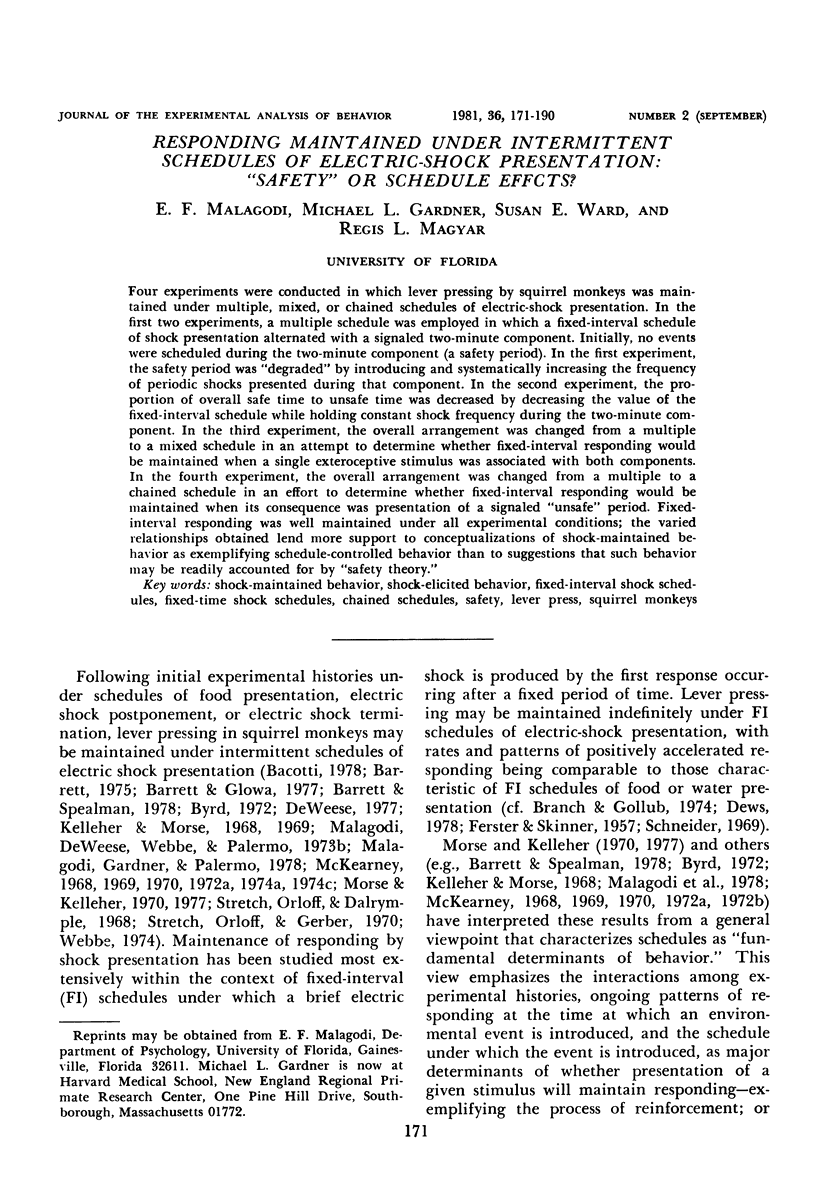



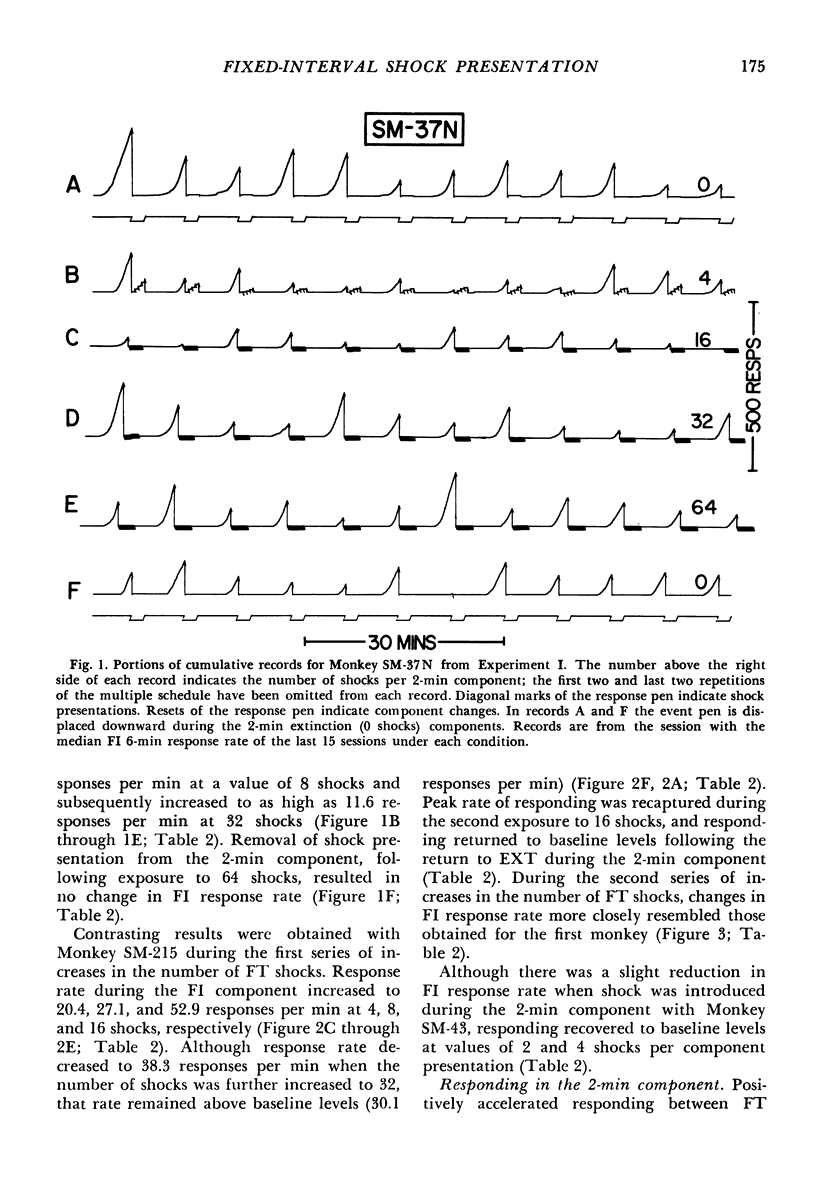
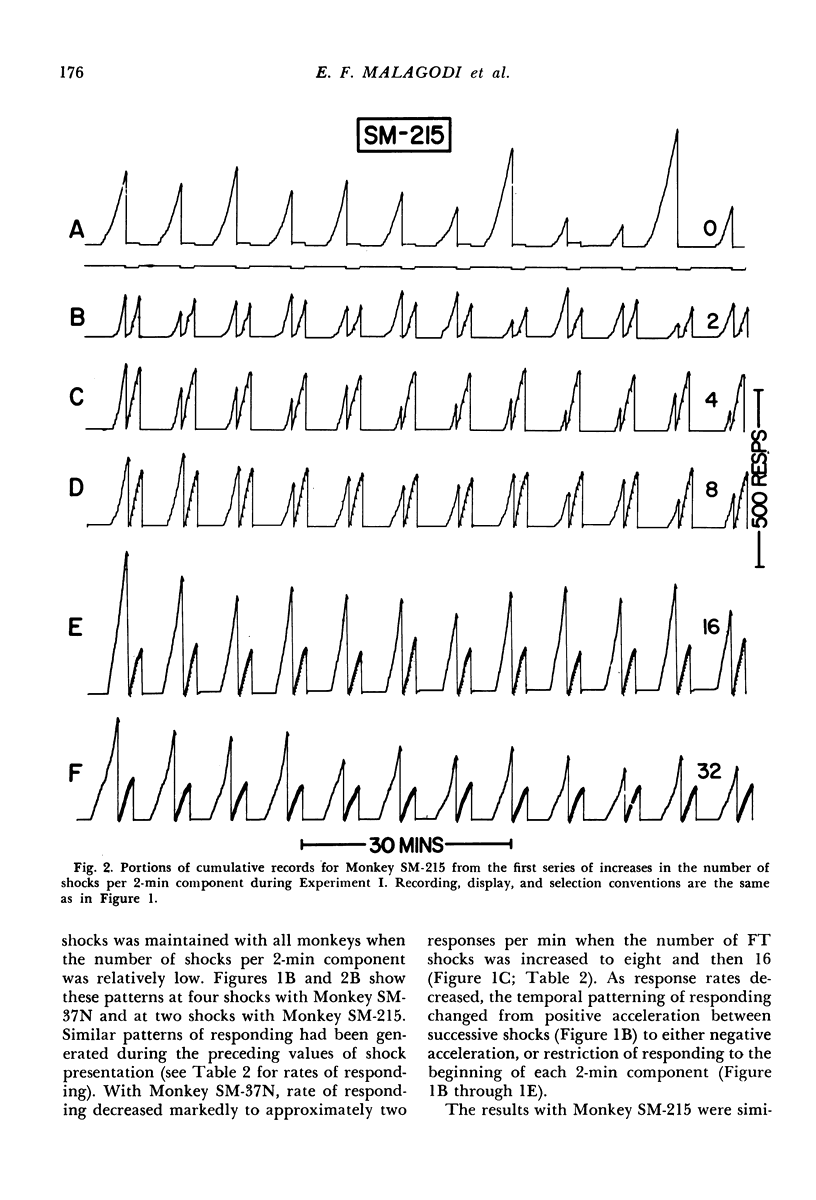


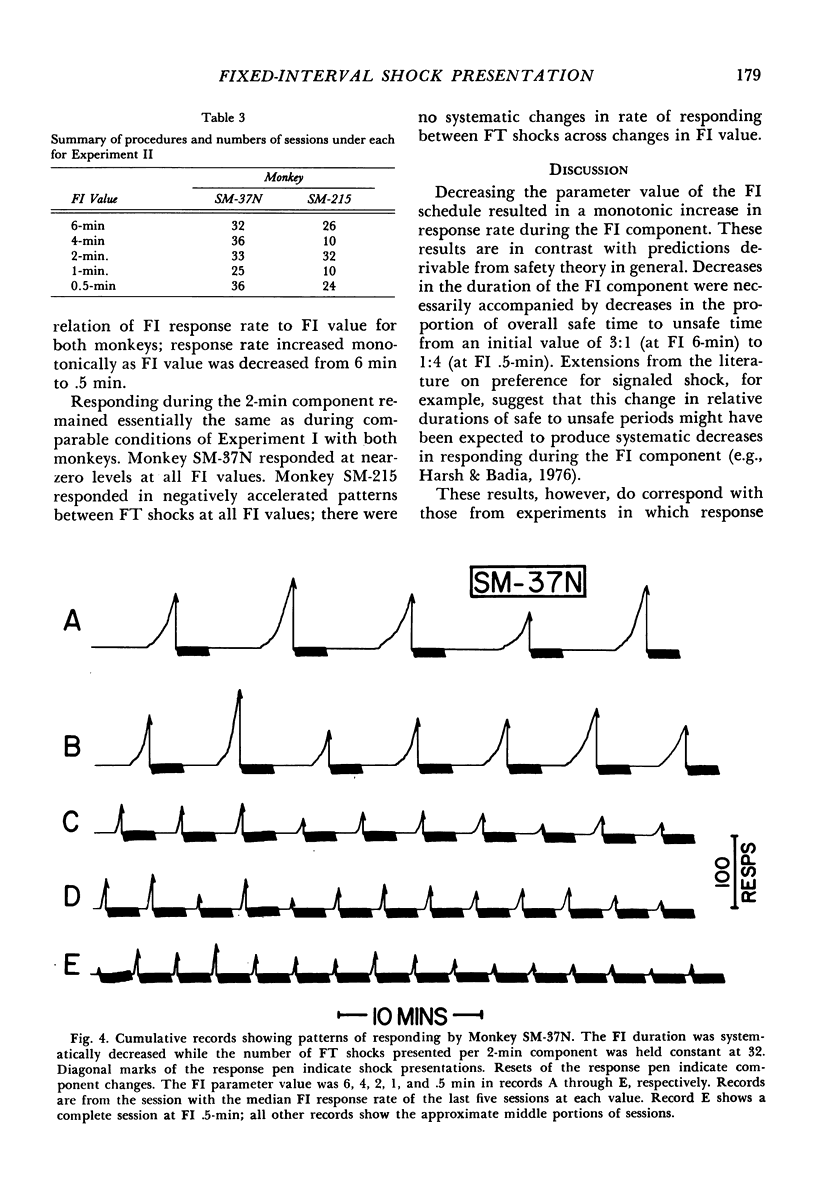
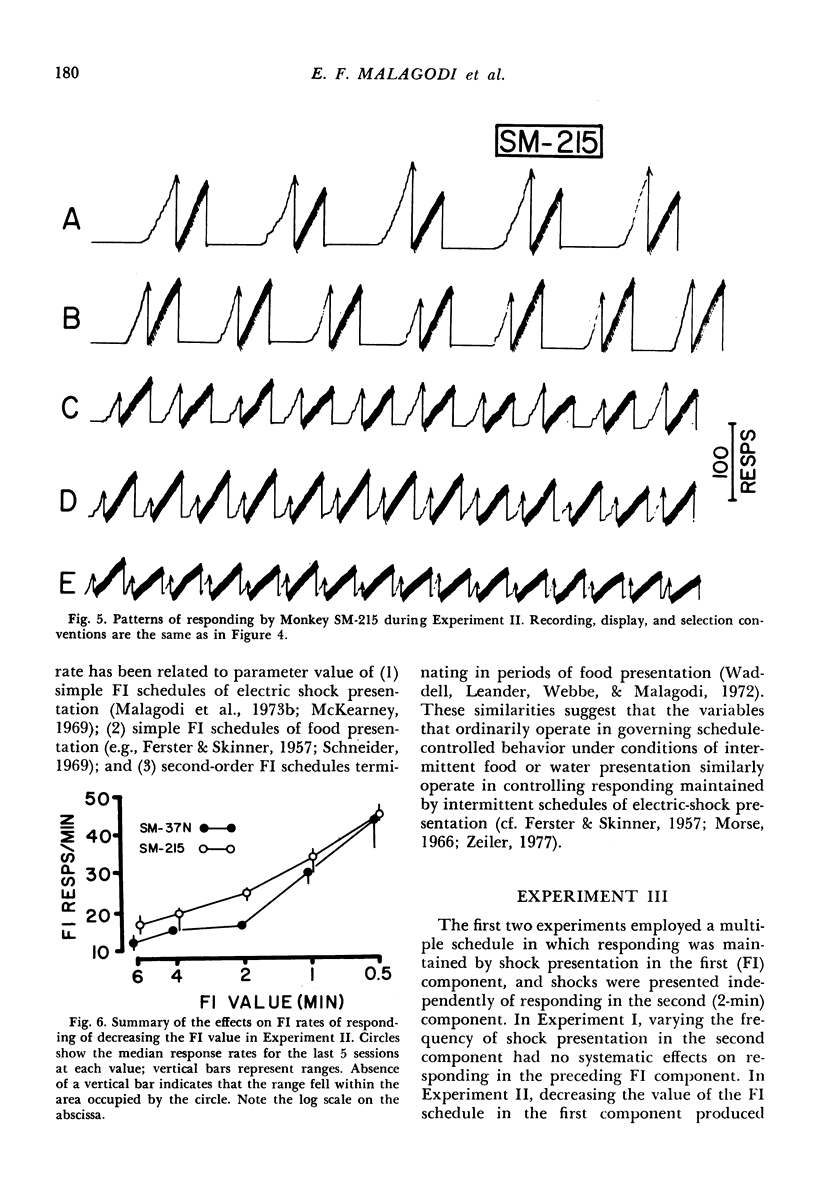


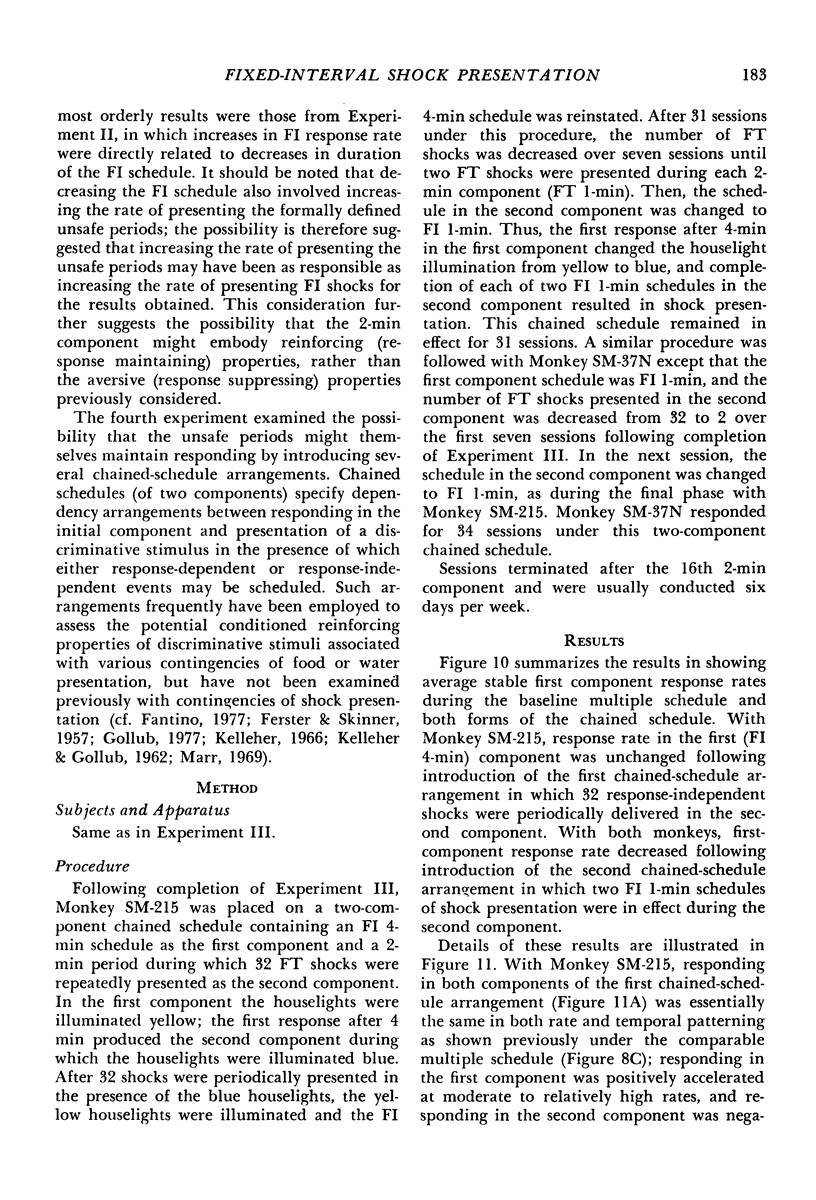
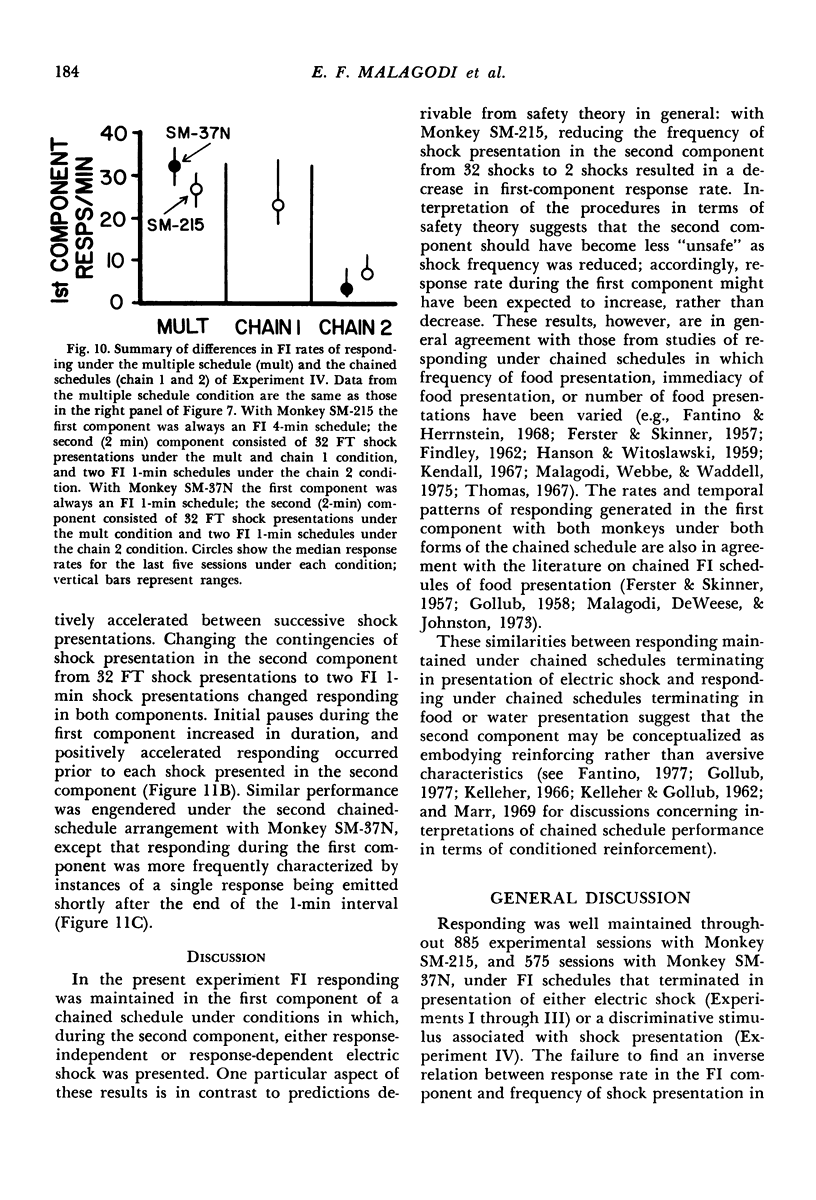
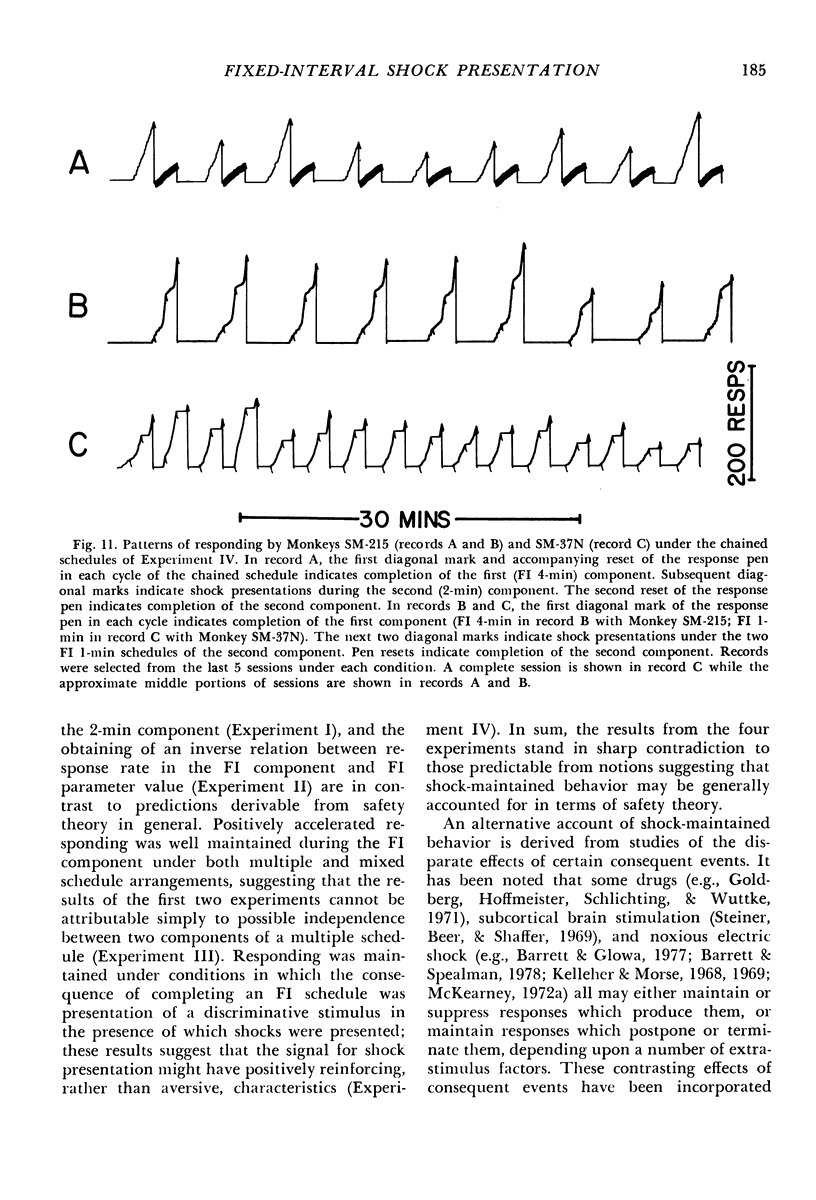
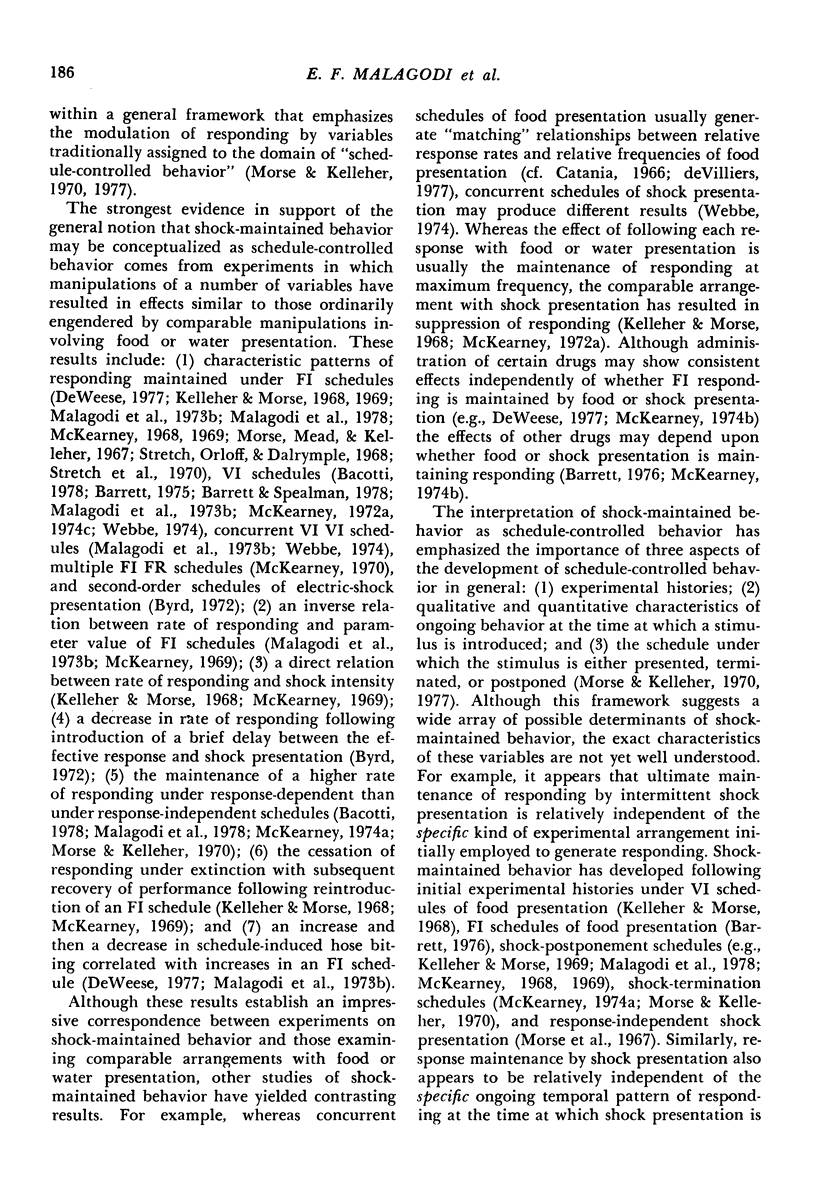
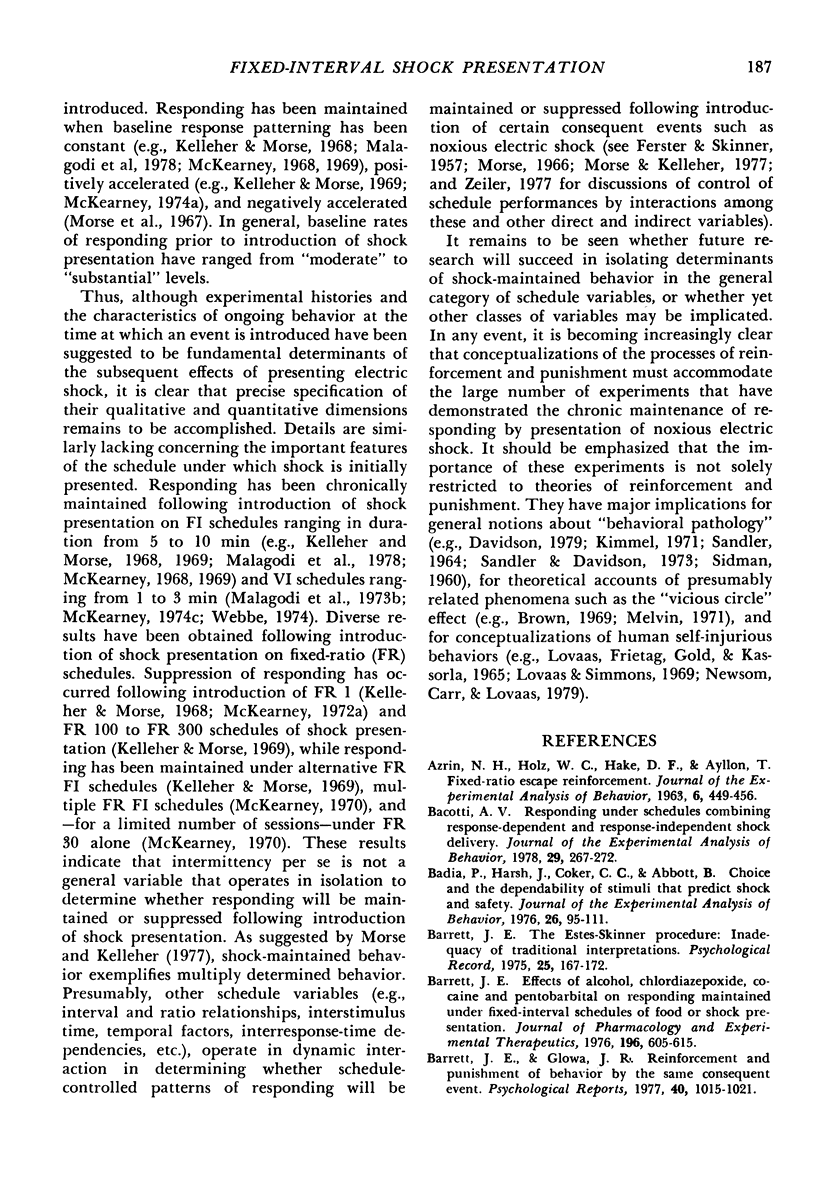



Selected References
These references are in PubMed. This may not be the complete list of references from this article.
- AZRIN N. H., HOLZ W. C., HAKE D. F., AYLLON T. Fixed-ratio escape reinforcement. J Exp Anal Behav. 1963 Jul;6:449–456. doi: 10.1901/jeab.1963.6-449. [DOI] [PMC free article] [PubMed] [Google Scholar]
- Bacotti A. V. Responding under schedules combining response-dependent and response-independent shock delivery. J Exp Anal Behav. 1978 Mar;29(2):267–272. doi: 10.1901/jeab.1978.29-267. [DOI] [PMC free article] [PubMed] [Google Scholar]
- Badia P., Harsh J., Coker C. C., Abbott B. Choice and the dependability of stimuli that predict shock and safety. J Exp Anal Behav. 1976 Jul;26(1):95–111. doi: 10.1901/jeab.1976.26-95. [DOI] [PMC free article] [PubMed] [Google Scholar]
- Barrett J. E. Effects of alcohol, chlordiazepoxide, cocaine and pentobarbital on responding maintained under fixed-interval schedules of food or shock presentation. J Pharmacol Exp Ther. 1976 Mar;196(3):605–615. [PubMed] [Google Scholar]
- Barrett J. E., Spealman R. D. Behavior simultaneously maintained by both presentation and termination of noxious stimuli. J Exp Anal Behav. 1978 May;29(3):375–383. doi: 10.1901/jeab.1978.29-375. [DOI] [PMC free article] [PubMed] [Google Scholar]
- Branch M. N., Gollub L. R. A detailed analysis of the effects of d-amphetamine on behavior under fixed-interval schedules. J Exp Anal Behav. 1974 May;21(3):519–539. doi: 10.1901/jeab.1974.21-519. [DOI] [PMC free article] [PubMed] [Google Scholar]
- Byrd L. D. Responding in the squirrel monkey under second-order schedules of shock delivery. J Exp Anal Behav. 1972 Jul;18(1):155–167. doi: 10.1901/jeab.1972.18-155. [DOI] [PMC free article] [PubMed] [Google Scholar]
- DINSMOOR J. A. Variable-interval escape from stimuli accompanied by shocks. J Exp Anal Behav. 1962 Jan;5:41–47. doi: 10.1901/jeab.1962.5-41. [DOI] [PMC free article] [PubMed] [Google Scholar]
- Deweese J. Schedule-induced biting under fixed-interval schedules of food or electric-shock presentation. J Exp Anal Behav. 1977 May;27(3):419–431. doi: 10.1901/jeab.1977.27-419. [DOI] [PMC free article] [PubMed] [Google Scholar]
- Dews P. B. Studies on responding under fixed-interval schedules of reinforcement: II. The scalloped pattern of the cumulative record. J Exp Anal Behav. 1978 Jan;29(1):67–75. doi: 10.1901/jeab.1978.29-67. [DOI] [PMC free article] [PubMed] [Google Scholar]
- Eubanks J. L., Killeen P., Hamilton B., Wald B. A. The effect of timeout on performance on a variable-interval schedule of electric-shock presentation. J Exp Anal Behav. 1975 May;23(3):457–463. doi: 10.1901/jeab.1975.23-457. [DOI] [PMC free article] [PubMed] [Google Scholar]
- FINDLEY J. D. An experimental outline for building and exploring multi-operant behavior repertoires. J Exp Anal Behav. 1962 Jan;5(Suppl):113–166. doi: 10.1901/jeab.1962.5-s113. [DOI] [PMC free article] [PubMed] [Google Scholar]
- Fantino E., Herrnstein R. J. Secondary reinforcement and number of primary reinforcements. J Exp Anal Behav. 1968 Jan;11(1):9–14. doi: 10.1901/jeab.1968.11-9. [DOI] [PMC free article] [PubMed] [Google Scholar]
- Goldberg S. R., Hoffmeister F., Schlichting U., Wuttke W. Aversive properties of nalorphine and naloxone in morphine-dependent rhesus monkeys. J Pharmacol Exp Ther. 1971 Nov;179(2):268–276. [PubMed] [Google Scholar]
- HAKE D. F., AZRIN N. H. An apparatus for delivering pain shock to monkevs. J Exp Anal Behav. 1963 Apr;6:297–298. doi: 10.1901/jeab.1963.6-297. [DOI] [PMC free article] [PubMed] [Google Scholar]
- HANSON H. M., WITOSLAWSKI J. J. Interaction between the components of a chained schedule. J Exp Anal Behav. 1959 Apr;2:171–177. doi: 10.1901/jeab.1959.2-171. [DOI] [PMC free article] [PubMed] [Google Scholar]
- Harsh J., Badia P. A temporal parameter influencing choice between signalled and unsignalled shock schedules. J Exp Anal Behav. 1976 May;25(3):327–333. doi: 10.1901/jeab.1976.25-327. [DOI] [PMC free article] [PubMed] [Google Scholar]
- Herrnstein R. J., Hineline P. N. Negative reinforcement as shock-frequency reduction. J Exp Anal Behav. 1966 Jul;9(4):421–430. doi: 10.1901/jeab.1966.9-421. [DOI] [PMC free article] [PubMed] [Google Scholar]
- Herrnstein R. J. Method and theory in the study of avoidance. Psychol Rev. 1969 Jan;76(1):49–69. doi: 10.1037/h0026786. [DOI] [PubMed] [Google Scholar]
- Hineline P. N. Negative reinforcement without shock reduction. J Exp Anal Behav. 1970 Nov;14(3):259–268. doi: 10.1901/jeab.1970.14-259. [DOI] [PMC free article] [PubMed] [Google Scholar]
- KELLEHER R. T., GOLLUB L. R. A review of positive conditioned reinforcement. J Exp Anal Behav. 1962 Oct;5:543–597. doi: 10.1901/jeab.1962.5-s543. [DOI] [PMC free article] [PubMed] [Google Scholar]
- Kelleher R. T., Morse W. H. Schedules using noxious stimuli. III. Responding maintained with response-produced electric shocks. J Exp Anal Behav. 1968 Nov;11(6):819–838. doi: 10.1901/jeab.1968.11-819. [DOI] [PMC free article] [PubMed] [Google Scholar]
- Kelleher R. T., Morse W. H. Schedules using noxious stimuli. IV: An interlocking shock-postponement schedule in the squirrel monkey. J Exp Anal Behav. 1969 Nov;12(6):1063–1079. doi: 10.1901/jeab.1969.12-1063. [DOI] [PMC free article] [PubMed] [Google Scholar]
- Kendall S. B. Some effects of fixed-interval duration on response rate in a two-component chain schedule. J Exp Anal Behav. 1967 Jul;10(4):341–347. doi: 10.1901/jeab.1967.10-341. [DOI] [PMC free article] [PubMed] [Google Scholar]
- Lovaas O. I., Simmons J. Q. Manipulation of self-destruction in three retarded children. J Appl Behav Anal. 1969 Fall;2(3):143–157. doi: 10.1901/jaba.1969.2-143. [DOI] [PMC free article] [PubMed] [Google Scholar]
- Malagodi E. F., Deweese J., Johnston J. M. Second-order schedules: a comparison of chained, brief-stimulus, and tandem procedures. J Exp Anal Behav. 1973 Nov;20(3):447–460. doi: 10.1901/jeab.1973.20-447. [DOI] [PMC free article] [PubMed] [Google Scholar]
- Malagodi E. F., Gardner M. L., Palermo G. Responding maintained under fixed-interval and fixed-time schedules of electric shock presentation. J Exp Anal Behav. 1978 Nov;30(3):271–279. doi: 10.1901/jeab.1978.30-271. [DOI] [PMC free article] [PubMed] [Google Scholar]
- Malagodi E. F., Webbe F. M., Waddell T. R. Second-order schedules of token reinforcement: effects of varying the schedule of food presentation. J Exp Anal Behav. 1975 Sep;24(2):173–181. doi: 10.1901/jeab.1975.24-173. [DOI] [PMC free article] [PubMed] [Google Scholar]
- McKearney J. W. Effects of d-amphetamine, morphine and chlorpromazine on responding under fixed-interval schedules of food presentation or electric shock presentation. J Pharmacol Exp Ther. 1974 Jul;190(1):141–153. [PubMed] [Google Scholar]
- McKearney J. W. Fixed-interval schedules of electric shock presentation: extinction and recovery of performance under different shock intensities and fixed-interval durations. J Exp Anal Behav. 1969 Mar;12(2):301–313. doi: 10.1901/jeab.1969.12-301. [DOI] [PMC free article] [PubMed] [Google Scholar]
- McKearney J. W. Maintenance and suppression of responding under schedules of electric shock presentation. J Exp Anal Behav. 1972 May;17(3):425–432. doi: 10.1901/jeab.1972.17-425. [DOI] [PMC free article] [PubMed] [Google Scholar]
- McKearney J. W. Maintenance of responding under a fixed-interval schedule of electric shock-presentation. Science. 1968 Jun 14;160(3833):1249–1251. doi: 10.1126/science.160.3833.1249. [DOI] [PubMed] [Google Scholar]
- McKearney J. W. Responding under fixed-ratio and multiple fixed-interval fixed-ratio schedules of electric shock presentation. J Exp Anal Behav. 1970 Jul;14(1):1–6. doi: 10.1901/jeab.1970.14-1. [DOI] [PMC free article] [PubMed] [Google Scholar]
- Morse W. H., Mead R. N., Kelleher R. T. Modulation of elicited behavior by a fixed-interval schedule of electric shock presentation. Science. 1967 Jul 14;157(3785):215–217. doi: 10.1126/science.157.3785.215. [DOI] [PubMed] [Google Scholar]
- SANDLER J. MASOCHISM: AN EMPIRICAL ANALYSIS. Psychol Bull. 1964 Sep;62:197–204. doi: 10.1037/h0040597. [DOI] [PubMed] [Google Scholar]
- SIDMAN M. Avoidance conditioning with brief shock and no exteroceptive warning signal. Science. 1953 Aug 7;118(3058):157–158. doi: 10.1126/science.118.3058.157. [DOI] [PubMed] [Google Scholar]
- Schneider B. A. A two-state analysis of fixed-interval responding in the pigeon. J Exp Anal Behav. 1969 Sep;12(5):677–687. doi: 10.1901/jeab.1969.12-677. [DOI] [PMC free article] [PubMed] [Google Scholar]
- Seligman M. E. Chronic fear produced by unpredictable electric shock. J Comp Physiol Psychol. 1968 Oct;66(2):402–411. doi: 10.1037/h0026355. [DOI] [PubMed] [Google Scholar]
- Sidman M. Normal Sources of Pathological Behavior. Science. 1960 Jul 8;132(3419):61–68. doi: 10.1126/science.132.3419.61. [DOI] [PubMed] [Google Scholar]
- Steiner S. S., Beer B., Shaffer M. M. Escape from self-produced rates of brain stimulation. Science. 1969 Jan 3;163(3862):90–91. doi: 10.1126/science.163.3862.90. [DOI] [PubMed] [Google Scholar]
- Stretch R., Orloff E. R., Dalrymple S. D. Maintenance of responding by fixed-interval schedule of electric shock presentation in squirrel monkeys. Science. 1968 Nov 1;162(3853):583–586. doi: 10.1126/science.162.3853.583. [DOI] [PubMed] [Google Scholar]
- Thomas J. R. Chained and tandem fixed-interval schedule performance and frequency of primary reinforcement. Psychol Rep. 1967 Apr;20(2):471–480. doi: 10.2466/pr0.1967.20.2.471. [DOI] [PubMed] [Google Scholar]
- Weiss S. J. An effective and economical sound-attenuation chamber. J Exp Anal Behav. 1970 Jan;13(1):37–39. doi: 10.1901/jeab.1970.13-37. [DOI] [PMC free article] [PubMed] [Google Scholar]


